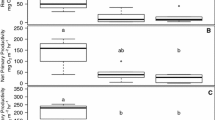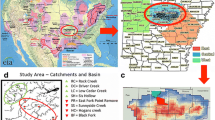Abstract
Acid mine drainage (AMD) impairs many streams throughout the historical and current coal mining regions. Abandoned mines often have sulfur-rich coal that produces sulfuric acid after exposure to water and oxygen. These streams are characterized by lowered pH, increased metal load, and decreased biotic assemblage complexity in comparison to unimpaired streams. Remediation efforts using alkaline addition have been successful in reducing the impacts of AMD by improving the chemical environment and reestablishing biotic assemblages that more closely resemble unimpacted streams. We used phospholipid fatty acids (PLFA) to detect changes in biofilm fatty acid profiles, differences in specific fatty acid biomarkers, and nutritional quality among AMD-unimpaired, AMD-impaired, and AMD-remediated stream sites in southeastern Ohio (USA). In general, the physical, chemical, and biological measurements of the remediated sites were intermediate between the unimpaired and impaired streams. PLFA content was five times greater in AMD-unimpaired sites when compared to AMD-impaired and double that of AMD-remediated sites. PLFA profiles separated sites of the three categories into two statistically distinct groups: AMD-unimpaired/AMD-remediated and AMD-impaired. The results of this study showed that PLFA profiles have great promise as an additional metric to evaluate AMD impact for stream biomonitoring programs.



Similar content being viewed by others
References
Ahlgren, G., Gustafsson, I.-B., & Boberg, M. (1992). Fatty acid content and chemical composition of freshwater microalgae1. Journal of Phycology, 28(1), 37–50. doi:10.1111/j.0022-3646.1992.00037.x.
Arar, E. J., & Collins, G. B. (1997). U.S. Environmental Protection Agency Method 445.0. In vitro determination of chlorophyll a and pheophytin a in marine and freshwater algae by fluorescence, revision 1.2. Cincinnati, Ohio: U.S. Environmental Protection Agency National Exposure Research Laboratory, Office of Research and Development.
Baker, B. J., & Banfield, J. F. (2003). Microbial communities in acid mine drainage. FEMS Microbiology Ecology, 44(2), 139–152. doi:10.1016/S0168-6496(03)00028-X.
Ben-David, E. A., Holden, P. J., Stone, D. J. M., Harch, B. D., & Foster, L. J. (2004). The use of phospholipid fatty acid analysis to measure impact of acid rock drainage on microbial communities in sediments. Microbial Ecology, 48(3), 300–315.
Bott, T. L., Jackson, J. K., McTammany, M. E., Newbold, J. D., Rier, S. T., Sweeney, B. W., & Battle, J. M. (2012). Abandoned coal mine drainage and its remediation: impacts on stream ecosystem structure and function. Ecological Applications, 22(8), 2144–2163. doi:10.1890/11-1735.1.
Bowman, J. R., & Johnson, K. S. (2015). An evaluation of water quality, biology, and acid mine drainage reclamation in five watersheds: Raccoon Creek, Monday Creek, Sunday Creek, Huff Run, and Leading Creek. Voinovich School of Leadership and Public Affairs at Ohio University. http://watersheddata.com/userview_file.aspx?UserFileLo=1&UserFileID=173.
Brett, M. T., & Mü Ller-Navarra, D. C. (1997). The role of highly unsaturated fatty acids in aquatic food web processes. Freshwater Biology, 38(3), 483–499.
Cashman, M. J., Wehr, J. D., & Truhn, K. (2013). Elevated light and nutrients alter the nutritional quality of stream periphyton. Freshwater Biology, 58(7), 1447–1457.
Church, C. D., Wilkin, R. T., Alpers, C. N., Rye, R. O., & McCleskey, R. B. (2007). Microbial sulfate reduction and metal attenuation in pH 4 acid mine water. Geochemical Transactions, 8, 10–23. doi:10.1186/1467-4866-8-10.
Cunnane, S. C. (2003). Problems with essential fatty acids: time for a new paradigm? Progress in Lipid Research, 42(6), 544–568. doi:10.1016/S0163-7827(03)00038-9.
DeForest, J. L., Smemo, K. A., Burke, D. J., Elliott, H. L., & Becker, J. C. (2012). Soil microbial responses to elevated phosphorus and pH in acidic temperate deciduous forests. Biogeochemistry, 109(1–3), 189–202. doi:10.1007/s10533-011-9619-6.
DeNicola, D. M., & Lellock, A. J. (2015). Nutrient limitation of algal periphyton in streams along an acid mine drainage gradient. Journal of Phycology, 51(4), 739–749. doi:10.1111/jpy.12315.
DeNicola, D. M., & Stapleton, M. G. (2014). Benthic diatoms as indicators of long-term changes in a watershed receiving passive treatment for acid mine drainage. Hydrobiologia, 1–20. doi:10.1007/s10750-014-1842-4.
DeNicola, D. M., Layton, L., & Czapski, T. R. (2012). Epilithic community metabolism as an indicator of impact and recovery in streams affected by acid mine drainage. Environmental Management, 50(6), 1035–1046. doi:10.1007/s00267-012-9936-0.
Findlay, R. H., Trexler, M. B., & White, D. C. (1990). Response of a benthic microbial community to biotic disturbance. Marine ecology progress series. Oldendorf, 62(1), 135–148.
Genter, R. B., & Lehman, R. M. (2000). Metal toxicity inferred from algal population density, heterotrophic substrate use, and fatty acid profile in a small stream. Environmental Toxicology and Chemistry, 19(4), 869–878. doi:10.1002/etc.5620190413.
Gray, N. F. (1997). Environmental impact and remediation of acid mine drainage: a management problem. Environmental Geology, 30(1–2), 62–71. doi:10.1007/s002540050133.
Hogsden, K. L., & Harding, J. S. (2012a). Anthropogenic and natural sources of acidity and metals and their influence on the structure of stream food webs. Environmental Pollution, 162, 466–474. doi:10.1016/j.envpol.2011.10.024.
Hogsden, K. L., & Harding, J. S. (2012b). Consequences of acid mine drainage for the structure and function of benthic stream communities: a review. Freshwater Science, 31(1), 108–120.
Honeyfield, D. C., & Maloney, K. O. (2015). Seasonal patterns in stream periphyton fatty acids and community benthic algal composition in six high-quality headwater streams. Hydrobiologia, 744(1), 35–47. doi:10.1007/s10750-014-2054-7.
Jackson, T. A., Vlaar, S., Nguyen, N., Leppard, G. G., & Finan, T. M. (2015). Effects of Bioavailable Heavy Metal Species, Arsenic, and Acid Drainage from Mine Tailings on a Microbial Community Sampled Along a Pollution Gradient in a Freshwater Ecosystem. Geomicrobiology Journal, 32(8), 724–750. doi:10.1080/01490451.2014.969412.
Johnson, K. S. (2009). Performance of a family-level macroinvertebrate index (MAIS) for assessing acid mine impacts on streams in the Western Allegheny Plateau. Ohio University.
Johnson, D. B., & Hallberg, K. B. (2005). Acid mine drainage remediation options: a review. Science of the Total Environment, 338(1–2), 3–14.
Johnson, K. S., Thompson, P. C., Gromen, L., & Bowman, J. (2014). Use of leaf litter breakdown and macroinvertebrates to evaluate gradient of recovery in an acid mine impacted stream remediated with an active alkaline doser. Environmental Monitoring and Assessment, 186(7), 4111–4127. doi:10.1007/s10661-014-3684-y.
Kleinmann, R. L., Hornberger, B., Leavitt, B., & Hyman, D. M. (2000). Introduction and Recommendations. In Prediction of water Quality at Surface Coal Mines (pp. 1–7). Morgantown, W. Va.: National Mine Land Reclamation Center, West Virginia University.
Kruse, N. A., Bowman, J. R., Mackey, A. L., McCament, B., & Johnson, K. S. (2012). The Lasting Impacts of Offline Periods in Lime Dosed Streams: A Case Study in Raccoon Creek, Ohio. Mine Water and the Environment, 31(4), 266–272. doi:10.1007/s10230-012-0194-4.
Lowe, R.L., & Pan, Y. (1996). Benthic algal communities as biological monitors. In R. J. Stevenson, M. Bothwell and R. L. Lowe (Eds.), Algal ecology: freshwater benthic ecosystems (pp. 705–739). San Diego, Academic Press.
McCune, B., & Grace, J. B. (2002). Analysis of Ecological Communities. MjM Software Design.https://www.researchgate.net/profile/James_Grace/publication/216769990_Analysis_of_ecological_communities/links/0a85e5318e69b2ae7f000000.pdf.
Mosher, J. J., & Findlay, R. H. (2011). Direct and indirect influence of parental bedrock on streambed microbial community structure in forested streams. Applied and Environmental Microbiology, 77(21), 7681–7688. doi:10.1128/AEM.06029-11.
Müller-Navarra, D. C., Brett, M. T., Liston, A. M., & Goldman, C. R. (2000). A highly unsaturated fatty acid predicts carbon transfer between primary producers and consumers. Nature, 403(6765), 74–77. doi:10.1038/47469.
Napolitano, G. E., Hill, W. R., Guckert, J. B., Stewart, A. J., Nold, S. C., & White, D. C. (1994). Changes in periphyton fatty acid composition in chlorine-polluted streams. Journal of the North American Benthological Society, 13(2), 237–249. doi:10.2307/1467242.
Niyogi, D. K., Lewis, W. M., Jr., & McKnight, D. M. (2002). Effects of stress from mine drainage on diversity, biomass, and function of primary producers in mountain streams. Ecosystems, 5(6), 554–567.
Niyogi, D. K., Cheatham, C. A., Thomson, W. H., & Christiansen, J. M. (2009). Litter breakdown and fungal diversity in a stream affected by mine drainage. Fundamental and Applied Limnology/Archiv für Hydrobiologie, 175(1), 39–48. doi:10.1127/1863-9135/2009/0175-0039.
Niyogi, D. K., Harding, J. S., & Simon, K. S. (2013). Organic matter breakdown as a measure of stream health in New Zealand streams affected by acid mine drainage. Ecological Indicators, 24, 510–517. doi:10.1016/j.ecolind.2012.08.003.
Pool, J. R., Kruse, N. A., & Vis, M. L. (2013). Assessment of mine drainage remediated streams using diatom assemblages and biofilm enzyme activities. Hydrobiologia, 709(1), 101–116. doi:10.1007/s10750-012-1440-2.
R Core Team (2013). R: A language and environment for statistical computing. R Foundation for Statistical Computing, Vienna, Austria. http://www.R-project.org/. Accessed 1 December 2015
Schowe, K., & Harding, J. (2014). Development of two diatom-based indices: a biotic and a multimetric index for assessing mine impacts in New Zealand streams. New Zealand Journal of Marine and Freshwater Research, 48(2), 163–176. doi:10.1080/00288330.2013.852113.
Schubotz, F., Meyer-Dombard, D. R., Bradley, A. S., Fredricks, H. F., Hinrichs, K.-U., Shock, E. L., et al. (2013). Spatial and temporal variability of biomarkers and microbial diversity reveal metabolic and community flexibility in Streamer Biofilm Communities in the Lower Geyser Basin, Yellowstone National Park. Geobiology, 11(6), 549–569. doi:10.1111/gbi.12051.
Smucker, N. J., & Vis, M. L. (2009). Use of diatoms to assess agricultural and coal mining impacts on streams and a multiassemblage case study. Journal of the North American Benthological Society, 28(3), 659–675. doi:10.1899/08-088.1.
Smucker, N. J., & Vis, M. L. (2011). Acid mine drainage affects the development and function of epilithic biofilms in streams. Journal of the North American Benthological Society, 30(3), 728–738. doi:10.1899/10-139.1.
Smucker, N. J., Drerup, S. A., & Vis, M. L. (2014). Roles of benthic algae in the structure, function, and assessment of stream ecosystems affected by acid mine drainage. Journal of Phycology, 50(3), 425–436. doi:10.1111/jpy.12184.
Torres-Ruiz, M., & Wehr, J. D. (2010). Changes in the nutritional quality of decaying leaf litter in a stream based on fatty acid content. Hydrobiologia, 651(1), 265–278. doi:10.1007/s10750-010-0305-9.
Torres-Ruiz, M., Wehr, J. D., & Perrone, A. A. (2007). Trophic relations in a stream food web: importance of fatty acids for macroinvertebrate consumers. Journal of the North American Benthological Society, 26(3), 509–522. doi:10.1899/06-070.1.
Underwood, B. E., Kruse, N. A., & Bowman, J. R. (2014). Long-term chemical and biological improvement in an acid mine drainage-impacted watershed. Environmental Monitoring and Assessment, 1–15. doi:10.1007/s10661-014-3946-8
Verb, R. G., & Vis, M. L. (2005). Periphyton assemblages as bioindicators of mine-drainage in unglaciated Western Allegheny Plateau lotic systems. Water, Air, and Soil Pollution, 161(1–4), 227–265. doi:10.1007/s11270-005-4285-8.
Vestal, J., & White, D. (1989). Lipid analysis in microbial ecology—quantitative approaches to the study of microbial communities. Bioscience, 39(8), 535–541. doi:10.2307/1310976.
Vinten, A. J. A., Artz, R. R. E., Thomas, N., Potts, J. M., Avery, L., Langan, S. J., et al. (2011). Comparison of microbial community assays for the assessment of stream biofilm ecology. Journal of Microbiological Methods, 85(3), 190–198.
White, D. C., Davis, W. M., Nickels, J. S., King, J. D., & Bobbie, R. J. (1979). Determination of the sedimentary microbial biomass by extractible lipid phosphate. Oecologia, 40(1), 51–62. doi:10.1007/BF00388810.
Zalack, J. T., Smucker, N. J., & Vis, M. L. (2010). Development of a diatom index of biotic integrity for acid mine drainage impacted streams. Ecological Indicators, 10(2), 287–295. doi:10.1016/j.ecolind.2009.06.003.
Acknowledgments
We would like to acknowledge Jessica Lindner for her assistance in collecting field samples and laboratory analysis. Sites used in this study were selected with the assistance of Jen Bowman and Kelly Johnson. Comments provided by Jared Deforest, Kelly Johnson, Brian McCarthy, and three anonymous reviewers greatly enhanced the quality of this manuscript. Funding was supplied in part by the Ohio University Graduate Student Senate Original Works Grant. Assistantship support was provided to S. Drerup from the American Energy Power Foundation Graduate Assistantship for Watershed Assessment and Restoration awarded through the Voinovich School of Leadership and Public Affairs.
Author information
Authors and Affiliations
Corresponding author
Ethics declarations
Conflict of Interest
The authors declare that they have no conflict of interest.
Rights and permissions
About this article
Cite this article
Drerup, S.A., Vis, M.L. Responses of Stream Biofilm Phospholipid Fatty Acid Profiles to Acid Mine Drainage Impairment and Remediation. Water Air Soil Pollut 227, 159 (2016). https://doi.org/10.1007/s11270-016-2856-5
Received:
Accepted:
Published:
DOI: https://doi.org/10.1007/s11270-016-2856-5




